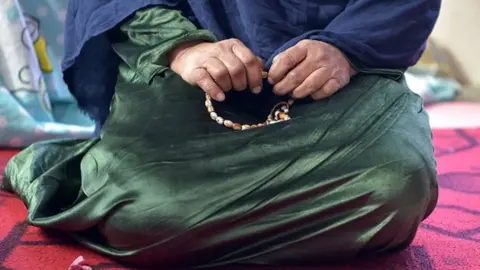
The Taliban Government in Afghanistan and the Violation of Women’s Rights
Date: 15 December 2023
- By Nicholas Yong, BBC News

The UN Report on Women Abuse Survivors in Afghanistan
- The Taliban government in Afghanistan is putting women abuse survivors in prison and claiming it is for their protection, according to a UN report.
The UN report emphasizes the violation of women’s rights in Afghanistan by the Taliban government. It highlights the harmful impact of this practice on the mental and physical health of the survivors.
- No More State-Sponsored Women’s Shelters
The report also reveals that there are no more state-sponsored women’s shelters in Afghanistan, as the Taliban government does not see the need for such centers.
- Taliban’s Suppression of Women’s Rights
The Taliban’s suppression of women’s rights in Afghanistan is considered one of the harshest in the world.
- Gender-Based Violence and Crises in Afghanistan
The United Nations Assistance Mission in Afghanistan (UNAMA) states that gender-based violence against Afghan women and girls was already high before the Taliban took over the country. However, since then, such incidents have become even more common due to the economic, financial, and humanitarian crises in Afghanistan. The report highlights how women have been increasingly confined to their homes, which increases their vulnerability to domestic and intimate partner violence.
- Disappearance of Women’s Protection Centers
Before the Taliban regained power in 2021, there were 23 state-sponsored women’s protection centers or shelters in Afghanistan. However, these shelters have since vanished, as the Taliban officials believe that women should be with their husbands or male family members. The officials consider these shelters to be “a western concept.”
- Placing Survivors in Prison for “Protection”
In cases where a survivor has no male relatives to stay with or when there are safety concerns, the Taliban government sends the survivor to prison “for her protection.” This is similar to how some drug addicts and homeless people are housed in the capital Kabul, according to UNAMA. However, the report argues that confining vulnerable women in a punitive environment amounts to an arbitrary deprivation of liberty and negatively impacts their mental and physical health.
- Inconsistent Handling of Gender-Based Violence Complaints
UNAMA also notes that the Taliban administration’s handling of gender-based violence complaints has been unclear and inconsistent. There is no clear distinction between criminal and civil complaints, which fails to ensure effective legal protection for women and girls. Furthermore, the absence of women personnel discourages survivors from lodging complaints. As a result, survivors are no longer guaranteed redress for their complaints, including civil remedies and compensation.
- Reversal of Women’s Rights
Efforts to advance women’s rights in Afghanistan between 2001 and 2021, including law and policy reforms, have all but disappeared since the Taliban regained power in 2021. The Taliban government has broken their earlier promises to give women the right to work and study. Girls are only allowed to attend primary school, and teenage girls and women have been barred from entering school and university classrooms. They are also restricted from parks, gyms, and pools. Beauty salons have been shut down, and women must dress in a way that only reveals their eyes. Additionally, women must be accompanied by a male relative if they are traveling more than 72km (45 miles).
SDGs, Targets, and Indicators Analysis
1. Which SDGs are addressed or connected to the issues highlighted in the article?
- SDG 5: Gender Equality
- SDG 16: Peace, Justice, and Strong Institutions
The article highlights the Taliban government’s suppression of women’s rights in Afghanistan, which directly relates to SDG 5 on Gender Equality. The article also mentions the handling of gender-based violence complaints by the Taliban government, which connects to SDG 16 on Peace, Justice, and Strong Institutions.
2. What specific targets under those SDGs can be identified based on the article’s content?
- SDG 5.2: Eliminate all forms of violence against all women and girls in public and private spheres
- SDG 16.3: Promote the rule of law at the national and international levels and ensure equal access to justice for all
The article discusses the Taliban government’s practice of putting women abuse survivors in prison, claiming it is for their protection. This directly relates to SDG 5.2, which aims to eliminate all forms of violence against women and girls. Additionally, the article mentions the unclear and inconsistent handling of gender-based violence complaints by the Taliban government, which connects to SDG 16.3 on promoting the rule of law and ensuring equal access to justice.
3. Are there any indicators mentioned or implied in the article that can be used to measure progress towards the identified targets?
- Number of women abuse survivors put in prison
- Existence and accessibility of state-sponsored women’s protection centers or shelters
- Presence of women personnel in handling gender-based violence complaints
- Guarantee of redress for survivors’ complaints, including civil remedies and compensation
- Extent of women’s rights restrictions, such as access to education, employment, and public spaces
The article mentions the practice of putting women abuse survivors in prison, indicating a potential indicator for measuring progress towards SDG 5.2. The disappearance of state-sponsored women’s protection centers or shelters can also serve as an indicator. The absence of women personnel in handling gender-based violence complaints and the lack of guarantee for redress are additional indicators. Lastly, the restrictions on women’s rights, such as access to education, employment, and public spaces, can be used to measure progress towards SDG 5.2 and SDG 16.3.
SDGs, Targets, and Indicators Table
| SDGs | Targets | Indicators |
|---|---|---|
| SDG 5: Gender Equality | 5.2: Eliminate all forms of violence against all women and girls in public and private spheres |
|
| SDG 16: Peace, Justice, and Strong Institutions | 16.3: Promote the rule of law at the national and international levels and ensure equal access to justice for all |
|
Copyright: Dive into this article, curated with care by SDG Investors Inc. Our advanced AI technology searches through vast amounts of data to spotlight how we are all moving forward with the Sustainable Development Goals. While we own the rights to this content, we invite you to share it to help spread knowledge and spark action on the SDGs.
Fuente: bbc.com

Join us, as fellow seekers of change, on a transformative journey at https://sdgtalks.ai/welcome, where you can become a member and actively contribute to shaping a brighter future.





